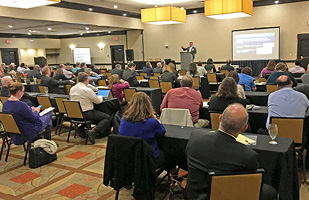Courts in the Cloud and Tech Talk Dominate Conference

Hundreds of judges, magistrates, and court personnel attended the Ohio Judicial Conference’s Court Technology Conference in Worthington.

Hundreds of judges, magistrates, and court personnel attended the Ohio Judicial Conference’s Court Technology Conference in Worthington.
Representatives from across the state came to Central Ohio to not only enhance the technology of their court operations, but make them more efficient and cost effective.
More than 200 judges, magistrates, and court personnel attended the Ohio Judicial Conference’s (OJC) annual Court Technology Conference in Worthington this week.
The daylong event was comprised of multiple sessions and workshops highlighting some of the latest trends to make the legal process more accessible to those who need it, while minimizing a court’s resources in fulfilling its requirements.
At the forefront of innovation and simplification is the push to make more elements of the process digital. Filing documents electronically and being able to sign them digitally allows all parties to make progress on a matter instantaneously from anywhere, even on their phone.
There’s also text messaging, email reminders of court appearances, fines and payment due dates, and juror reporting notifications. These methods have shown a significant decrease in the number of people missing their court dates, as well as the number of warrants issued for failing to appear in court.
“Courts are beginning to operate very differently than they did, say 10 years ago,” said Ashland County Common Pleas Court Judge Ronald Forsthoefel. “My court is entirely cloud-based. That means we can operate our case management system, document assembly and processing, and even conduct a number of different types of hearings from anywhere. We are no longer confined by brick-and-mortar locations.”
With the courts able to provide more information and options on how they conduct business, websites, such as Ohio Legal Help, help guide those in need of legal assistance to figure out the forms they need and where they need to go.
“This saves court resources when the court does not have to act as attorney to a non-represented person and saves people who use courts’ time and money by making the court more accessible,” said Marta Mudri, OJC legislative counsel.
Along with tutorials about the operational approach regarding tech upgrades, there were lessons on structural and financial implementation. Presenters discussed the importance of what decision makers need to know before making a big purchase.
“A lot of times, you have to conform to the way they do it, and I think that's a big obstacle because the clerks not only have to learn a new a system, but a new way of doing things altogether,” said Bonnie Gold, the clerk of court and court administrator for Sidney Municipal Court.
Given that certain jurisdictions are more limited with the means they have for their courts, Ohio Supreme Court Chief Justice Maureen O’Connor initiated the Ohio Courts Technology Initiative in 2015 to help with funding. On Thursday, the Court announced it will issue $2.9 million in technology grants to 47 local court projects for upgrades and improvements on their current systems.

